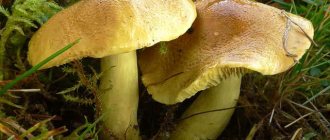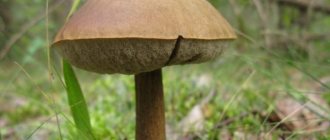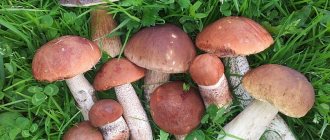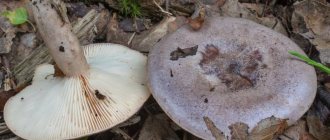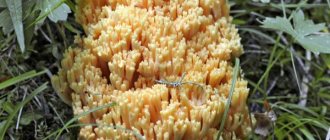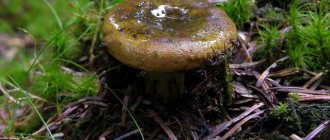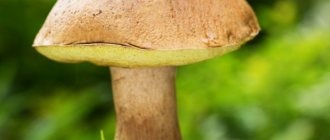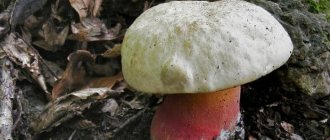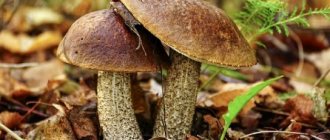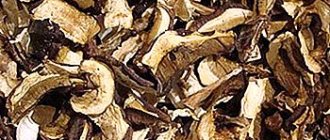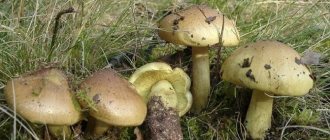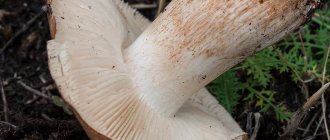Description of the mushroom
This species is also known in the literature and among the people under other names:
- the milkman is the best;
- milkweed;
- milk mushroom red-brown;
- smoothie;
- underbaby;
- registry;
- redneck
The milkweed mushroom (Lactarius volemus) belongs to the Russula family, the genus Milky.
Few people put this representative of the mushroom kingdom in their basket, since it is not as well known as, for example, the black milk mushroom or the yellow row. But true connoisseurs of the unique taste of milkweed walk tens of kilometers to find it. A detailed description and special characteristics of this species, and there are many of them, make it possible not to confuse milkweed with other relatives.
What does it look like
The spurge mushroom is quite large in size . Its cap reaches 15 cm in diameter, in rare cases - 20 cm, fleshy, in the early stages - convex, slightly concave in the middle with edges curved towards the stem. Over time, it acquires a prostrate or funnel-shaped shape.
Did you know? In Italy, spurge is considered the most valuable mushroom. Sauces made from it are served in the most expensive restaurants for a lot of money.
The skin is dry to the touch, velvety, and often cracks due to age and lack of moisture. The surface is matte, brown-red, red, red-yellow or light orange, without concentric circles. The center of the hat is always darker than the edges.
The leg of the milkweed is thick, reaches 4 cm in diameter and from 4 cm to 12 cm in height, has the shape of a cylinder, flat or slightly widened in the middle. In young mushrooms it is dense, but with age it becomes hollow and tubular. The surface of the leg is velvety, smooth, pleasant to the touch. The color is the same as the cap, or slightly lighter, which is more common.
The pulp is dense, but fragile, white in color, and darkens when cracked when chapped. Has a sweetish taste. Older mushrooms have a distinct smell of herring, crab or sunflower. When damaged, both the cap and the stem secrete abundantly milky juice, which has a sweetish or resinous-bitter taste.
When exposed to air, the milk darkens to brown and changes consistency, becoming caramel-sticky. The milkweed blades are white with a yellowish or pinkish tint and darken with age. They are often located, have a straight or fork-shaped shape, and slightly descend along the stem.
Red-brown breast milk (Lactarius volemus)
Synonyms:
- Galorrheus volumemus
- Lactifluus volumemus
- Amanita lactiflua
- Lactarius lactifluus
- Lactifluus oedematopus
- Lactarius oedematopus
- Lactarius ichoratus
- Galorrheus ichoratus
- Lactifluus ichoratus
- Lactarius testaceus
- Mlechnik is the best (by the way, the official Russian-language mycological name)
- Podoreshnik (Belarusian – Padareshnik)
Lactarius volumemus (Fr.) Fr., Epicr. syst. mycol. (Upsaliae): 344 (1838)
Description
The cap is 5-17 (up to 16) cm in diameter, convex in youth, then spread out, possibly depressed in the center, and even concave. The edge of the cap is straight, thin, sharp, at first tucked in, then straightens and even rises. The color is reddish-brown, brownish-brown, in rare cases rusty or light ocher. The surface is first velvety, then smooth and dry. Often cracked, especially in drought. There is no zonal coloration.
Pulp: White, yellowish, very fleshy and dense. The smell is described in various ways, mainly as a herring (trimethylamine) smell that increases with age, but there are also more interesting associations, for example with pear flowers, or not specified at all. The taste is soft, pleasant, sweetish.
The plates are frequent, from adherent to slightly descending, cream or warm skin tones, often forked at the stem. There are shortened plates (lamellae).
The milky juice is abundant, white, turning brown and thickening in air. For this reason, in this type of milkweed, everything else turns brown when damaged - the pulp, the plates.
Leg 5-8 (up to 10) cm high, diameter (1) 1.5-3 cm, hard, often cap-colored, but slightly paler, smooth, may be covered with fine pubescence, which looks like frost, but not to the touch is felt. Often narrowed towards the bottom.
The spore powder is white. The spores are close to spherical, according to 8.5–9 x 8 µm, 9-11 x 8.5-10.5 µm. The ornamentation is ridge-shaped, up to 0.5 microns high, forming an almost complete network.
Habitat
Found from July to October. One of the earliest lacticians. Grows in deciduous, mixed and spruce forests (in general, in all forests). According to the data, it forms mycorrhiza with oak (Quercus L.), common hazel (Corylus avellana L.) and spruce (Picea A. Dietr.).
Similar species
Considering the “power” of this mushroom and the abundant brownish sweetish milky juice, perhaps it has no similar species. The most similar lactifer to it is, perhaps, the hygrophoroid milkweed - Lactarius hygrophoroides, but it is easily distinguished by its non-browning milky sap and sparse plates. Quite conventionally, the rubella (Lactarius subdulcis) can be classified as a similar species, but it is thin-fleshed and delicate. The same applies to the orange milkweed (Lactarius aurantiacus = L.mitissimus), it is not only small and thin, but also late, does not overlap in terms of timing, although it grows in exactly the same biotopes with spruce.
Edibility
An edible mushroom that can even be eaten raw. It is good in raw pickled or pickled form, without any heat treatment. I don’t like it in its other form because of the “wooden” pulp, although they say it makes good mushroom caviar. I hunt for it specifically and purposefully, for the sake of raw salting.
References1) Verbeken, A. & Vesterholt, J. 2008. Lactarius. – In: Knudsen, H. & Vesterholt, J. (eds.): Funga Nordica, 82-107.2) Flora of Belarus. Mushrooms. In 7 volumes. Volume 1. O.S. Gapienko, Y.A. Shaporova, 2012, Boletales. Amanitales. Russulales.
Video about the Euphorbia mushroom:
Varieties and lookalikes
An experienced mushroom picker will never confuse the red-brown milk mushroom with anything else, but novice lovers of quiet hunting can still mistake some of its other relatives for it :
- gray-pink milkweed ( Lactarius helvus
) is very similar in appearance, although much paler; moreover, it does not secrete abundant milky sap on a break or cut, and has a characteristic smell of dry grass without a sweetish tint; - the hygrophoroid milkweed ( Lactarius hygrophoroides
) differs from the common sap in that its milky sap does not change color when weathered, and the plates under the hat are located much less frequently; - the non-caustic milkweed ( Lactarius mitissimus
) does not grow in diameter more than 7 cm, the hat never cracks; - neutral milkweed ( Lactarius quietus
) secretes a yellowish milky sap that does not change color when weathered and has no characteristic odor.
Where does it grow?
If you want to find a milkweed mushroom, you can do it this way: it grows in one copy in hard-to-reach places. It can often be found in coniferous or deciduous forests. Good growth is ensured by moss and rotten stumps located near the growing season.
Sparrowwood has a very pleasant taste and is classified in the fourth quality category. They can be eaten salted or boiled. These mushrooms do not require pre-soaking. But there are some exceptions. It will be better if you eat only young mushrooms. Adults have a somewhat unpleasant odor and taste.
Growing
You can grow the spurge mushroom at home under any tree species, but nut plantations provide maximum germination and yield. In addition, such proximity significantly increases the fruiting of crops due to the formation of mycorrhiza.
Milkweed spores can be purchased at the store and sown according to the instructions:
- Mix 15 g of seeds with 0.5 liters of sand or dry soil (per 1 m²).
- Fluff up the soil under the tree, reaching the roots, to a depth of 5–15 cm.
- Distribute the mycelium over the area.
- Cover with garden, or better yet, forest soil, mixed in equal proportions with humus.
- Use a watering can with a fine sprayer to pour 10 liters of water per m².
- Mulch the top with soil and sawdust.
Did you know? Almost two thirds of mushrooms sold on the world market are
artificially grown in China.
You can obtain seed material yourself . To do this, you need to find old mushrooms without washing them, grind them in a meat grinder, add water and leave in a dark, warm place for 2 weeks. After time, the cake on top must be removed, and the remaining liquid will be a solution of milkweed spores.
Next, everything is done in the same way as with purchased material, only the mycelium will be distributed over the area not in dry form, but by watering. A harvest of red-brown milk mushroom can be expected within three months, then fruiting, subject to proper watering, will continue until the end of October.
Proper preparation is a guarantee of success
To make frozen lingonberry jam the best it can be, you need to know some rules. They will help you get the maximum benefit from the berries.
Remember:
- Use only ripe berries. Green and overripe fruits will only spoil the taste.
- Remove rotten berries immediately. They will significantly reduce the shelf life of the finished dish, especially when it comes to recipes without heat treatment.
- Take the trouble to thoroughly rinse and peel the berries. Fill the preparations with cold water so that the liquid completely covers the berries. Drain the water along with any floating debris. Then drain the lingonberries in a colander and let the liquid drain.
- In an aluminum container, the jam will quickly oxidize and acquire an unpleasant taste. Use better enamel containers.
You can learn more about how to make preparations correctly, as well as what else can be prepared from soaked lingonberries. And I’ll move on to the most important part of my story - proven recipes for delicious jam from sweet and sour lingonberries.
Benefits of mushroom
- Red-brown milk mushroom is characterized by a rich chemical composition, which includes:
- volemolide or mushroom estrogen;
- sugar alcohol;
- Volemitol;
- ethanol extract;
- sterol;
- cortisone;
- alimentary fiber;
- ash;
- vitamins B9, B6, B2, D, PP, E;
- trace elements: chromium, rubidium, cobalt, iron, fluorine and selenium, potassium, phosphorus, magnesium, calcium and sodium;
- useful acids: tyrosine, valine, lysine, threonine.
All these enzymes, vitamins and microelements make it possible to use the mushroom for the prevention and control of various diseases.
We recommend that you familiarize yourself with how to distinguish between edible and inedible mushrooms by appearance.
Use in cooking
For culinary purposes, it is better to use young mushrooms, since the older the mushroom, the more expressive the specific smell, which also intensifies during the cooking process.
Euphorbia belongs to the fourth taste category, so boiling and frying them is not recommended , although some mushroom pickers speak of fried euphorbia as a unique delicacy. Cold pickling allows you to preserve the maximum benefits of mushrooms and get a wonderful crispy snack for the whole winter.
Important! The red-brown breast is never affected by worms and insects. It does not need to be soaked before cooking.
The recipe is extremely simple:
- Rinse the mushrooms under running water.
- Separate the legs from the caps - this way they will fit compactly and correctly.
- Place milk mushrooms in layers in a wooden, ceramic or enamel container, sprinkling with coarse salt at the rate of 50 g of salt per 1 kg of mushrooms.
- Cover with gauze in 3-4 layers, place a wooden circle on top that fits the inner diameter of the container (you can use a plate or an enamel lid).
- Place the pan or barrel in a cold place for pickling for 1 month. During this time, the circle and gauze will need to be washed daily.
- A month has passed - take out the mushrooms and enjoy the unique taste.
How to cook
Euphorbia differs from other milkweeds in its bitter taste. After processing it becomes sweeter. It is recommended to salt or marinate the mushroom; it is also fried, dried and stewed. To do this, you need to take only young specimens that have a pleasant taste. Milkweed is classified as quality category 4. Such mushrooms are prepared by some amateurs who consider them a delicacy.
Euphorbia is more valued in the West than in Russia. However, many mushroom pickers in our country go out on a quiet hunt in the hope of meeting it on their way and prefer to eat milkweed in its raw form, that is, without pre-processing. It is better not to do this, because mushrooms are capable of accumulating harmful substances from the soil.
Before cooking, the collected mushrooms need to be boiled for 10-15 minutes. This will reduce the amount of toxins in the product, but the specific smell will not disappear. Before cold salting, you need to soak the mushrooms for 1-2 days. This should be done in a glass or enamel container, after first cleaning the mushrooms from dirt. This will help get rid of bitterness. Then the spurge is placed in a deep container and sprinkled with salt. For 3-3.5 kg of mushrooms you need 150 g of salt. The container is left in the refrigerator for 4 weeks. This salty dish is suitable for pizza, salads and as a snack.
Fried mushrooms with onions and sour cream
You can make many excellent dishes from milkweed. So, for example, to fry mushrooms with onions and sour cream, you will need:
- 800 g fresh mushrooms;
- 300 g sour cream;
- vegetable oil;
- 1 onion;
- Wheat flour;
- salt and pepper.
7 preparation steps:
- The mushrooms must be thoroughly washed and sorted, removing any debris.
- Then they need to be filled with cold water and sent to the fire, adding a pinch of salt.
- After boiling, cook the milkweed for 20 minutes, then drain the mushrooms in a colander and wait until the water has completely drained.
- Next, the boiled milk jugs are cut into cubes and fried in a frying pan with a thick bottom in heated vegetable oil.
- For a golden crust, you can bread them in flour.
- After 5 minutes, add the onion, cut into half rings, into the pan and continue cooking the food for 3-4 minutes.
- Then everything is poured with sour cream and seasoned with salt and pepper. This composition must be simmered for 10-15 minutes.
It is recommended to serve the dish hot, sprinkled with grated cheese and herbs.
Fried red-brown milk mushrooms with eggs and sour cream
This original recipe of eggs and mushrooms will surely appeal to many housewives. For it you will need:
- 6 chicken eggs;
- 250 g fried smoothies;
- 120 g hard cheese;
- salt pepper;
- 3 tbsp sour cream.
Let's prepare it like this:
It is necessary to mix mushrooms, grated cheese, pepper, salt and sour cream in a bowl, pre-fried until fully cooked. Boiled eggs are cut lengthwise into two halves and the yolk is removed from each. It can be added to the prepared mixture and ground. The resulting filling is placed in the egg halves and decorated with herbs.
It is advised to follow some rules when preparing dishes from milkweed:
- It is better to take a cleaning knife from stainless metal.
- Already prepared mushrooms need to be cooked immediately.
- Milkweed dishes are best consumed on the day of preparation.
- You can store fresh mushrooms that have not yet been processed in the refrigerator.
Milkweed is an excellent source of protein. And there is even more of it in dry mushrooms than in meat. Therefore, it is recommended to eat milkweed during the diet. Its calorie content is 65 kcal.
Application in medicine
The spurge mushroom has a large number of beneficial properties, due to which it is widely used in folk medicine. The most valuable is the milky juice, which has a powerful antitumor effect.
Fresh mushrooms contain an ethanol extract, which is often used in the fight against various malignant tumors, including cancer. The presence of cortisone in tissues allows it to be used in products to combat inflammation and rheumatism.
Milkweed tincture is taken 1 tsp. 3 times a day for varicose veins, hemorrhoids, gout, otitis media, bronchitis, fever, sore throat, gastrointestinal diseases and inflammatory processes.
When you have a runny nose, lubricate the nasal mucosa with an oil composition. External use of the tincture helps solve problems of skin inflammation, cure burns, allergic rashes, etc.
- In addition, the red-brown milk mushroom performs a number of other functions:
- blocks the spread and removes bad cholesterol;
- has an antioxidant effect;
- helps restore the microflora of the digestive tract;
- Helps replenish proteins and proteins in a healthy diet.
Recipe for milkweed mushroom tincture in oil
To prepare a milkweed tincture in oil, the mushrooms must first be dried. To do this, they are cut into 1 cm thick plates and hung in shaded, well-ventilated places. You can also use an electric dryer.
Important! Before use, the tincture should be shaken thoroughly until smooth.
After the raw material has completely dried, it is ground into powder with a coffee grinder or blender and poured with linseed or olive oil at the rate of 0.5 liters of oil per 3 tbsp. l. mushroom powder. The container is tightly closed and left to infuse in a warm, dark place for two weeks. There is no need to strain the composition. It can be stored in the refrigerator for several years.
How to collect
Euphorbia forms microsas with deciduous and coniferous trees. It is found low in the mountains, along paths and roads, in damp places, near rotten stumps and moss. The milkweed grows both alone and in groups. It is never damaged by larvae.
Despite the fact that the mushroom is quite widespread, it is not so easy to find. Gladysh is harvested from mid-summer to the end of September in many countries of Europe, America, Eurasia and Africa. The red-brown milk mushroom is especially common in the south of the forest belt of the Russian Federation.
Euphorbia has no poisonous counterparts. There are also no identical mushrooms among the laticifers. A striking distinctive feature of the smoothie is its milky juice, which stretches and has a specific smell.
The bright red milkweed is slightly similar in appearance to the hygrophoroid milkweed. However, the latter has very rare plates, so an experienced mushroom picker will be able to distinguish these two species without much difficulty. Euphorbia is also similar to the neutral milkweed, which is distinguished by its brownish skin with dark inclusions and yellowish milky juice. A novice mushroom picker may confuse it with the gray-pink milkweed, whose edibility has not been conclusively proven. The gray-pink milkweed has clear juice, and the smell resembles the aroma of dried grass. From afar, the milkweed of the true camelina appears.
When collecting milkweed, it is important to remember 4 simple rules:
- You cannot pick mushrooms near roads, factories or garbage dumps.
- There is no need to rush for the first harvest after the drought.
- The fruiting body must be cut off with a knife, and it is better to cover the mycelium with turf in order to return to this place again for a new harvest.
- You should not pick mushrooms that you are not familiar with.
Any mushroom, including spurge, cannot be stored fresh for a long time. Over time, it will begin to accumulate toxins that are harmful to the human body. Therefore, the maximum storage time for mushrooms is 15 hours, provided that the place is dark and cool.
What is the danger of the mushroom
The rich chemical composition not only helps fight diseases, but is the reason for the presence of a number of contraindications and warnings regarding its use. The spurge mushroom should not be consumed by pregnant women, children under 7 years of age, or breastfeeding mothers.
- In case of intolerance to one or more components of the mushroom, side effects may occur:
- skin itching;
- atopic dermatitis;
- gastrointestinal disorder;
- allergic rhinitis or ARVI;
- a sharp increase in temperature;
- headache;
- cough, shortness of breath.
People suffering from kidney disease, cholelithiasis, gastritis and gastric ulcers in an acute form should take medicines based on milkweed with extreme caution. Hypertensive patients are not recommended to consume more than 1 tsp. infusion per day. The mushroom has a stimulating effect on the nervous system, so it should not be eaten in any form later than three hours before bedtime.
Red-brown breast milk is a tasty and healthy product, but it is extremely difficult to find. Often, in search of a few mushrooms, you have to walk tens of kilometers through swampy areas, but believe me, they are worth the effort.
How to hot pickle milkweed
All mushroom pickers who don’t want to wait a whole month for mushrooms to pickle will love the hot method of preparing them. In order to pickle milkweed according to this recipe, it must first be boiled for 12 minutes. Then the mushrooms should be thrown into a sieve and wait until the water has completely drained. Boiled milkweed is placed in layers at the rate of 80 g of salt per 2 kg of mushrooms. After this, the container must be placed in a cold place where the required temperature is maintained from 0 to 10 degrees.
Euphorbia mushroom prepared according to this recipe can be tasted after 6 days. Mushroom pickers recommend adding it to salads with pickled onions and other vegetables.
